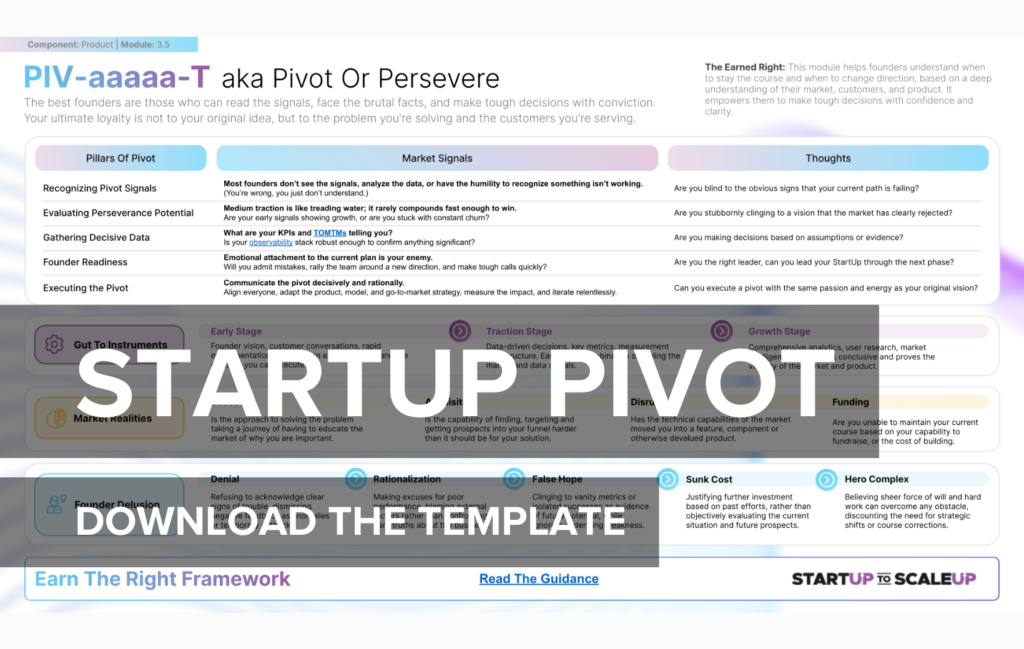How Can Startup Founders Pivot Effectively?
What is a pivot in the context of startups and why is it important?
A pivot in the startup context is a fundamental change in a company’s business strategy to test a new approach for its product, business model, or engine of growth. It’s important because:
- Market adaptation: Allows startups to respond to changing market conditions.
- Problem-solution fit: Helps find a better alignment between the problem and solution.
- Resource optimization: Redirects efforts towards more promising opportunities.
- Survival strategy: Can save a startup that’s struggling with its current approach.
- Growth catalyst: Often leads to breakthroughs in product-market fit and scalability.
Pivoting is a natural part of the startup journey, reflecting a company’s ability to learn and adapt quickly.
How can startup founders recognize when it’s time to pivot?
Founders should consider pivoting when they observe:
- Stagnant growth: User acquisition or revenue growth plateaus despite efforts.
- Low engagement: Users aren’t utilizing the product as frequently or deeply as expected.
- Market feedback: Consistent negative feedback or lack of enthusiasm from target users.
- Competitive pressures: New entrants or existing players making your approach less viable.
- Changing market conditions: Shifts in technology, regulations, or customer needs.
- Metric misalignment: Key performance indicators consistently falling short of targets.
It’s crucial to differentiate between normal startup challenges and systemic issues that require a pivot.
What are the key steps in executing a successful startup pivot?
Executing a successful pivot involves several key steps:
- Data analysis: Gather and analyze all available data on current performance.
- Market research: Re-evaluate market needs and opportunities.
- Team alignment: Ensure all team members understand and support the pivot.
- Strategy formulation: Develop a clear plan for the new direction.
- Rapid prototyping: Create and test new concepts quickly.
- Feedback loop: Establish mechanisms for gathering and acting on user feedback.
- Resource reallocation: Shift resources to support the new direction.
- Communication: Clearly articulate the pivot to all stakeholders.
Throughout the process, maintain flexibility and be prepared to iterate based on new insights.
How should founders communicate a pivot to team members and investors?
Effective pivot communication involves:
- Transparency: Be open about the reasons for the pivot and the data supporting it.
- Vision sharing: Clearly articulate the new vision and how it addresses market needs.
- Individual impact: Explain how the pivot affects each team member’s role.
- Investor perspective: Frame the pivot in terms of long-term value and opportunity.
- Confidence: Demonstrate conviction in the new direction while acknowledging risks.
- Listening: Encourage questions and feedback from team members and investors.
- Regular updates: Keep all stakeholders informed throughout the pivot process.
Remember, how you communicate the pivot can significantly impact team morale and investor confidence.
What role does customer feedback play in the pivot process?
Customer feedback is crucial in the pivot process:
- Problem identification: Helps pinpoint where current approach is falling short.
- Solution validation: Provides insights into whether new direction resonates with users.
- Feature prioritization: Guides decisions on what to build or change first.
- Market understanding: Deepens knowledge of customer needs and preferences.
- Iteration fuel: Drives continuous improvement of the pivoted product or service.
Implement systematic ways to gather, analyze, and act on customer feedback throughout the pivot process.
How can startups maintain team morale during a pivot?
Maintaining team morale during a pivot involves:
- Open communication: Keep team informed about reasons for and progress of the pivot.
- Involvement: Include team members in the pivot planning and execution process.
- Skills alignment: Help team members see how their skills fit into the new direction.
- Celebrate small wins: Recognize and reward progress along the pivot journey.
- Learning culture: Frame the pivot as an opportunity for growth and new challenges.
- Support systems: Provide resources to help team members adapt to changes.
- Leadership example: Demonstrate enthusiasm and commitment to the new direction.
Remember, team buy-in is crucial for a successful pivot. Addressing morale proactively can make the difference between success and failure.
How can startups measure the success of their pivot?
Measuring pivot success involves tracking:
- User adoption: How quickly are users embracing the new direction?
- Engagement metrics: Are users more actively using the pivoted product?
- Revenue growth: Is the new approach driving sustainable revenue increases?
- Customer feedback: Are users more satisfied with the pivoted offering?
- Market traction: Is the startup gaining more attention or market share?
- Team productivity: Has the pivot led to more efficient or effective operations?
- Investor interest: Is the new direction attracting more investor attention or support?
Set clear, measurable goals for your pivot and regularly assess progress against these benchmarks.
Pivoting is a challenging but often necessary step in a startup’s journey. It requires courage, clear thinking, and effective execution. By recognizing pivot signals early, making data-driven decisions, and communicating clearly with all stakeholders, founders can turn potential failure into new opportunities for success. Remember, some of the most successful companies today, like Slack, Instagram, and Twitter, emerged from significant pivots.
Approach pivoting not as a last resort, but as a strategic tool for finding your startup’s true potential in the market.
